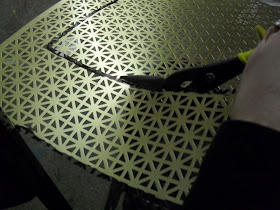I rented this juke box for a production of Always Patsy Cline. It's a great piece, mostly hollowed out, with a doors to make it look like an old 1950's fridge on the back (so we can shift easily from bar to kitchen). It has, however, seen better days and it needed a lot of love before I could put it on stage.
The biggest problem was the four plastic panels on the front. The top two were plexiglass, painted with gold stripes and so full of cracks that they were pretty much laminated together with packing tape.The bottom panels were made of corrugated plastic (which I am fairly sure was not the original material, but a fix someone had used in a previous show). It had scratches and paint marks all over it.
To replace them I needed something translucent, but I didn't want to go transparent (you can see in the previous images that the red party bulbs were visible behind the cracked plexiglass).
My first thought was to go with muslin, and to paint some sort of gold pattern onto it to break up the large expanses of white.
When I ran that idea past the set designer he suggested that maybe instead of painting we use radiator screen to get our pattern and provide us with a more rigid structure.
Radiator screen is a thin patterned metal available at most hardware stores. It is easy to cut with a pair of tin-snips and comes in a variety of patterns. It is not especially cheap ($30-$40 per sheet), but I was planning on making an investment in this prop so I could afford two sheets for this project.
I traced the pieces I was replacing onto the screen and cut them out.
Then I used spray adhesive to laminate some white taffeta I found in stock onto the back.
The hardest part was inserting them because they fit so tightly and the curves were awkward
On the plus side, the fit was so tight that once I got the pieces in, all I needed was a little hot glue to hold it there. Hot glue was also preferable because when I return the prop, if they decide to go back to the plexi panels, it should be able to pull right off of the metal without doing any permanent damage.
There are a few dents and creases in the screen that I couldn't get rid of, and I'm not sure how I could have avoided them considering all the twisting and pulling that was required to get the pieces in place.
But once the lights are on you hardly notice, and I think it turned out pretty well.









No comments:
Post a Comment